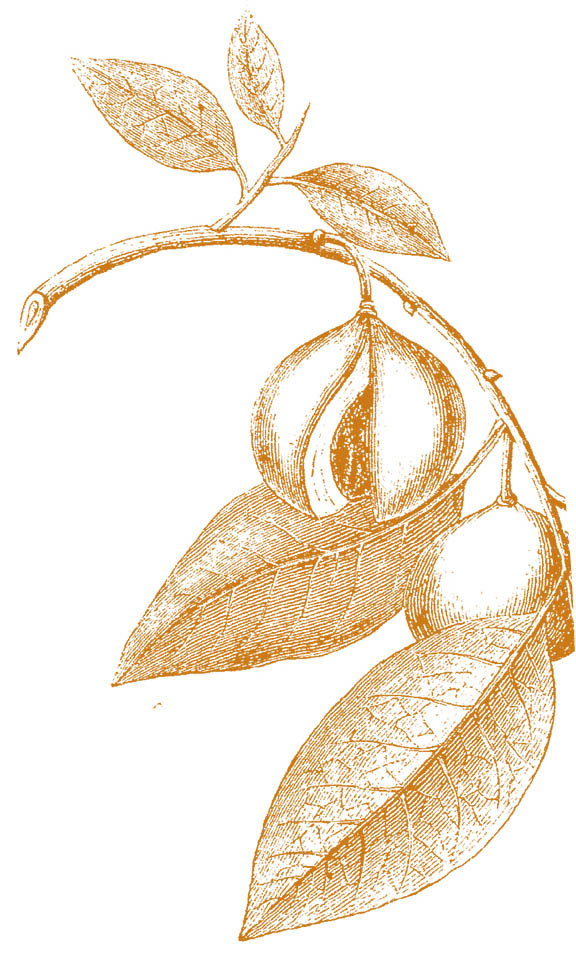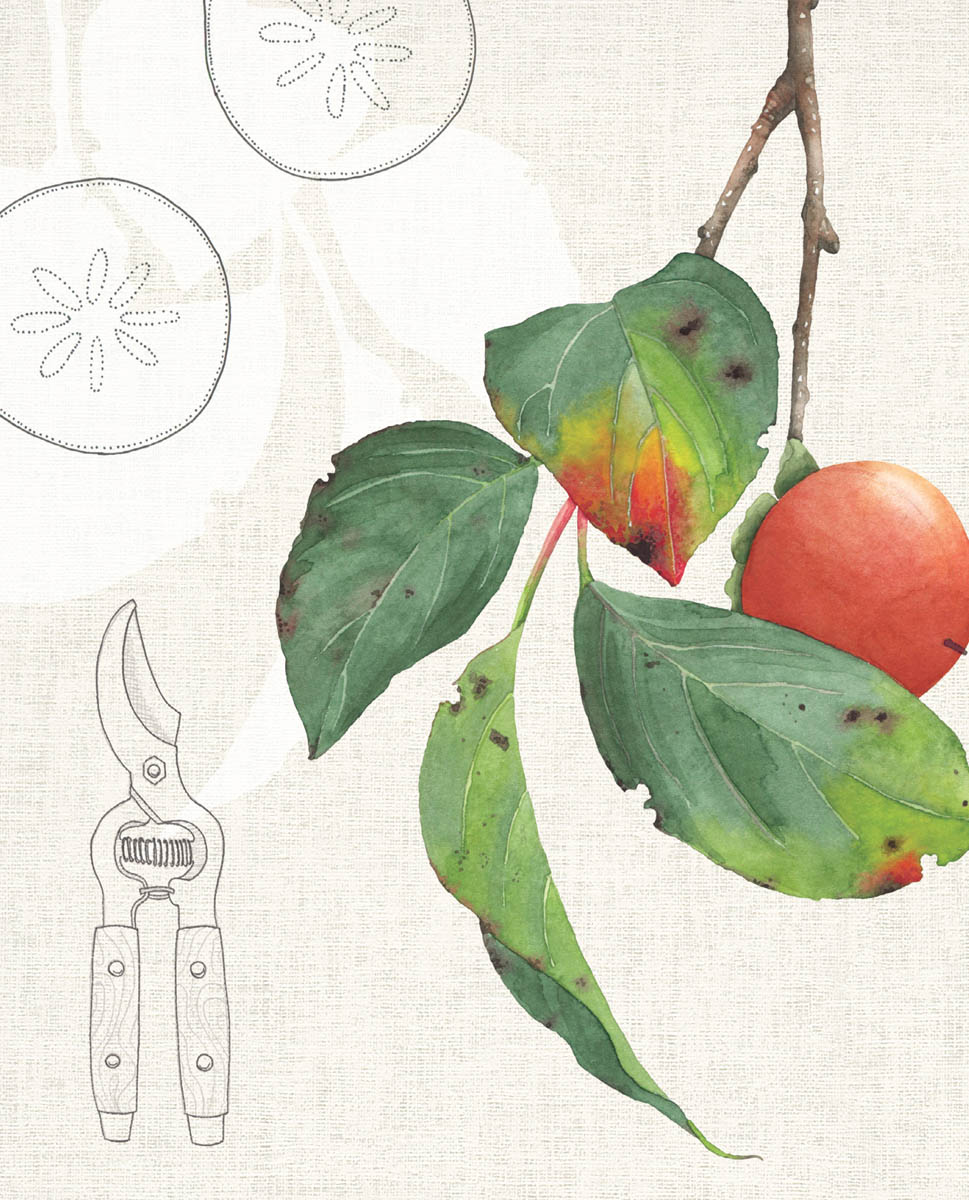

“A well-pruned, mature fruit tree is a beautiful sight.”
— Robert L. Stebbins and Lance Walheim, Western Fruit, Berries and Nuts
Imagine the quality of life of a feral chicken or a wild cow. A fruit tree is a domestic creature much like they are. Fruiting aside, if fruit trees are to be adequate even as trees, they need human intervention. A feral fruit tree is useless even to itself.
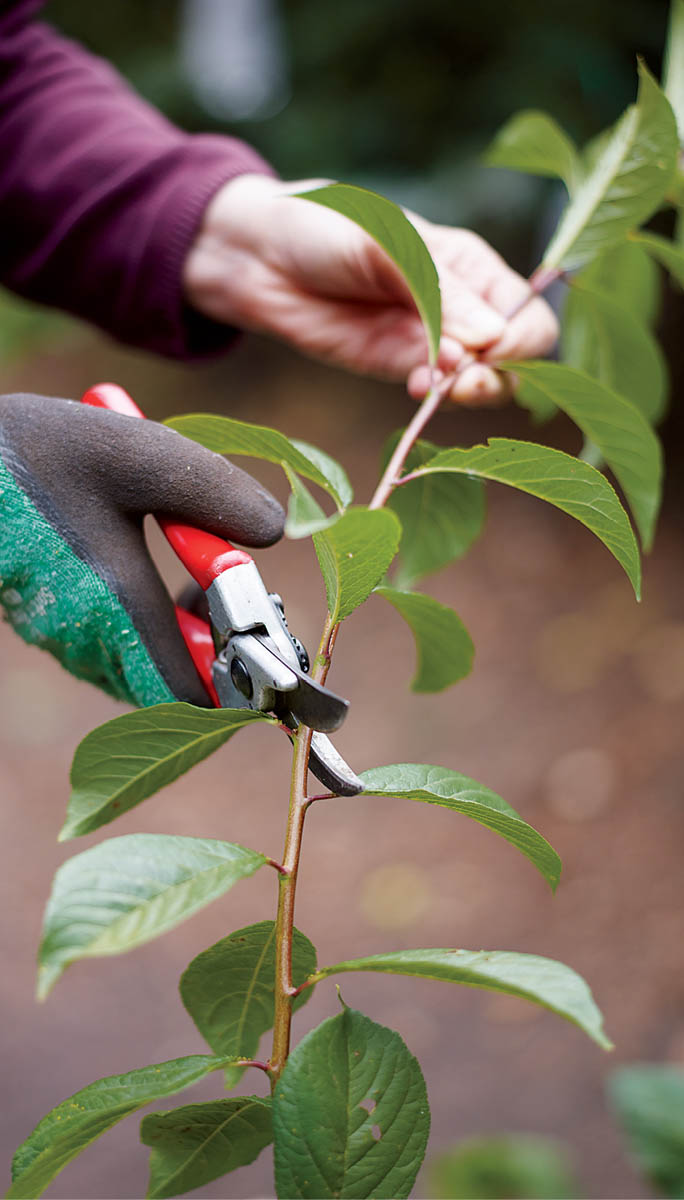
A pruner directs growth by favoring one bud over another.
There’s no way around it — fruit trees require pruning.
Abandoned orchards poignantly illustrate how fruit trees overproduce and break themselves down. Overgrown limbs block sunlight. When light can’t enter the center of a tree, fruit develops at the ends of branches too weak to support it. If nobody thins and spaces the fruit along the branches, the weight of too much fruit can crack a tree apart. Fruit from neglected trees is small, scant, or excessively abundant; bug-ridden; and mostly out of reach or rotten on the ground. Fruit left on the ground to rot harbors insects and disease and generates trouble for years to come.
Regardless of how large a fruit tree is allowed to grow, pruning builds structure into the tree. A fruit tree can’t adequately create this structure by itself. Regular pruning strengthens a fruit tree, rejuvenates it, encourages new fruiting wood, and maintains fruitfulness lower on the tree. In essence, pruning creates a sturdy and healthy tree, more fruit, and more reachable fruit. Regular pruning, winter and summer, is also one of the best ways to get acquainted with your fruit tree. Time spent pruning creates opportunities to monitor your tree’s progress and observe it for signs of trouble. Additionally, though by now it should go without saying, pruning is also the best way to keep a fruit tree small.
Luckily, pruning is simple. Only two types of pruning cuts exist. Pruning cuts are classified as either heading cuts or thinning cuts. When you grasp the difference between the two, you know much of what you need to know about pruning fruit trees or anything else.
Like other trees and shrubs, fruit trees grow from the tips of their branches. A heading cut removes part of a shoot or limb. It deprives that limb of a growing tip. A branch needs a growing tip to be able to grow. When the tip is removed, the remaining part of the branch makes hormonal adjustments that generate new growing tips by activating the buds left behind. The buds below the cut develop into new branch tips and grow to be new branches. A heading cut forces a limb to generate new growing tips in the form of new shoots.
Heading cuts shorten limbs. The newly generated growth below the cut increases branching and bushiness. Anyone who has sheared a hedge is familiar with the dense and shrubby consequences of many small heading cuts. Heading cuts made with hedge shears create the square and round shrubbery so common in commercial plantings.
The first prune for a newly planted fruit tree sapling is a dramatic heading cut that radically alters the growth pattern of the tree. This cut triggers the buds that will become sturdy, low-branching limbs and the major fruit-supporting branches. People conversant in fruit trees refer to these three or four major limbs collectively as scaffold limbs or simply as the scaffold.
Leaf buds circle a stem all the way around. If you do no pruning, leaf buds sometimes develop into branches but more usually develop into leaves. When you make a heading cut, you remove the growing tip and prune above a bud. That bud changes and becomes the primary growing tip. A pruner directs future growth by favoring one bud over another. An outside bud is nothing more than a bud that points away from the interior of the tree. Outside buds become limbs that grow in an outwardly direction away from the interior of the tree.
A thinning cut removes an entire branch or shoot at its point of origin, the place where the branch emerges from a limb. Thinning cuts subtract branches. These subtractions redirect a tree’s energy and growth into the limbs that remain and, consequently, to the growing tips that are left behind. Thinning cuts preserve growing tips, decrease the number of branches, reduce crowding, and open up the interior of the tree to light and air. This light is crucial for the formation of fruiting spurs, the squat twiglets that blossom and ultimately bear fruit. Judicious thinning also supports and reveals the natural shape of a tree. Most pruning cuts, winter or summer, will likely be thinning cuts, especially as a tree gets older.
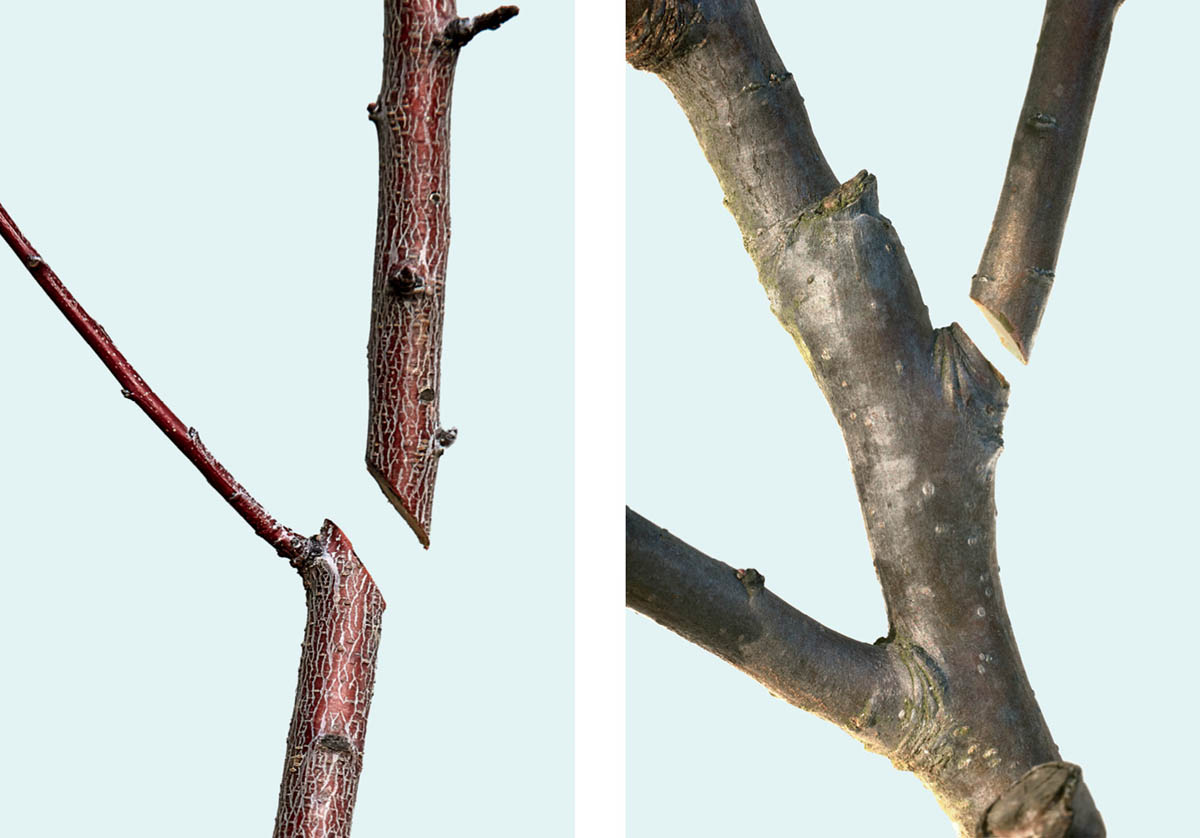
(L) A handsome heading cut angles with the direction of the bud and doesn’t leave a stub. (R) Thinning cuts subtract entire branches by removing them at their point of origin.
Branches heal so beautifully from properly executed pruning cuts that plant tissue almost seems designed with shears in mind. Pruning wounds from well-executed cuts callus cleanly and won’t detract from the natural lines of the tree.
A handsome heading cut follows the angle of the bud. Make the cut at an angle as close to a bud as possible. The bud nearest the pruning cut will determine what direction the limb will grow. A well-executed heading cut preserves the bud and doesn’t leave a stub.
A branch extends from its limb surrounded by two types of woody growth. A ridge forms at the top of a branch and marks where that branch separates from the supporting limb. The aptly described collar is thick tissue that surrounds the branch at its base. A perfect thinning cut angles to preserve both the ridge and the collar without leaving a stub.
Pruning cuts don’t heal the way skin heals. Instead, plant tissue grows to enclose the wound and seals it over to prevent the infestation of pests and disease. Trees adeptly heal themselves. Let them. Tree seal compounds interfere with this natural healing process and are no longer recommended.
In addition to the two types of pruning cuts, a pruner needs to understand the importance of timing. Timing matters. Plants react differently to pruning depending on the time of year or, more accurately, when pruning takes place in the seasonal cycle of the plant. How a tree responds to pruning depends on whether the tree is about to grow, actively growing, preparing for a dormant season, or fully dormant.
Deciduous trees cycle through an obvious pattern of growth and dormancy. They lose foliage all at once, usually in autumn, though not always. Some plants cope with drought conditions by defoliating and preserve themselves with a late summer dormancy — for example, the buckeyes on the hill behind my house, my dry-gardened rhubarb, and a certain never-watered fig of my acquaintance. Evergreen trees, including plants such as citrus, shed foliage year-round because they are never fully dormant, though they, too, have a growth spurt in spring.
Deciduous plants of all kinds, fruit trees included, push growth in spring from reserves stored during the latter half of the previous season. Deciduous fruit trees aggressively expend the energy stored in fall and winter when they bloom, leaf out, and most actively grow in spring and early summer. When spring arrives, the tree is in a mood to grow, and grow it will, often at an alarming rate, whether you got around to pruning it or not.
Once the leaves emerge, plants gather energy through photosynthesis and begin as early as July to return that energy to the trunk and roots, where it will rest in reserve all winter. In fall, the tree loses its foliage. It goes dormant, with resources stored and largely inactive, until the cycle begins again in spring.
If deciduous plants are pruned in late winter, the traditional pruning time, they outgrow the pruning with the full force of these stored reserves. When you want a plant to recover from pruning so it looks nice right away, prune in late winter, just before spring. Prune spring flowering shrubs as soon as flowers fade. Plants pruned in winter will, by June, be again as tall as they were in January, an advantage in some circumstances — if you expect the garden club to drop by, for instance — but useless for size control.
The summer solstice in late June marks the midpoint in the annual growth cycle. By the time of the solstice, a tree’s resources have migrated from the roots and trunk and are stored primarily in the foliage. Solstice pruning removes some of these resources. Fewer resources means less vigorous growth, much like cutting the calories of a too-energetic eater. Summer pruning slows a tree down, a desirable result when you have an interest in keeping your fruit tree small.
Prune near the solstice. Time summer pruning so it occurs near the summer solstice. In early summer, trees still have plenty of vigor to recover from pruning. They grow, but at a moderate pace. Pruning cuts made while a tree is still actively growing heal quickly, too. Peaches, plums, and apricots pruned in fall and winter can grow as much as eight feet the following spring. The same pruning cuts made in the solstice season yield growth of only a foot or so. Solstice pruning keeps fruit trees (and other garden shrubbery) in check.
The later in the summer you prune, the more you reduce the beneficial size control effects of summer pruning. By mid- to late summer, nutrients that leaves collect have already begun to store in the trunk and roots. As far as the tree is concerned, late summer pruning and pruning into September more resembles winter pruning. As early as August, a tree is headed into dormancy.
Winter is the best time to make structural and aesthetic decisions because the tree is bare. When a tree lacks foliage, it’s easy to evaluate the configuration of existing branches and decide what belongs and what doesn’t. You can see exactly how the tree is growing and determine what you need to do to help it.
Winter is the best time to remove poorly placed limbs. By that I mean anything that doesn’t look quite right — limbs that are too horizontal or branches that grow into the fence, are too crowded, or just seem wrong. You want to remove what Portland, Oregon, pruner John Iott calls the three Ds — “the dead, the diseased, and the disoriented.”
Winter is the best time to open up the interior with a few well-considered cuts that let in light and air. Observe the growth pattern of the tree and prune to enhance its natural grace. By removing awkward branches, you allow the tree to open up and begin to take form. Winter pruning is like editing. You remove what gets in the way so the real story can unfold.
Make heading cuts in winter only when you want an enthusiastic response — when you’re trying to develop the first low scaffold branches, for example, or when you’re trying to rejuvenate an older tree. Prune more heavily in winter only if a tree has stalled, if pruning has been neglected and the tree needs correction, or if you were too timid last time and want to generate some better choices this time around.
Suckers are limbs that grow from rootstock below the graft. Suckers can also pop up from surface roots some distance from the tree. Certain rootstocks are notorious for suckering, like the Marianna 2624 that is sometimes used with apricots, plums, and peaches. If left in place, suckers direct energy into their own growth, which diverts growth from the scion. Watch for thorny fast-growing suckers on citrus and remove them. When a citrus tree produces large fruit with a thick rind and a pithy interior, this “rough lemon” is the fruit of the rootstock. Suckers can outpace the topstock, leaving a tree that is primarily or entirely rootstock. Last summer, I had the opportunity to try a rootstock peach. It was small, yellow, and tart, and better than I expected, but rootstock fruit is not the fruit you had in mind when you planted your tree.
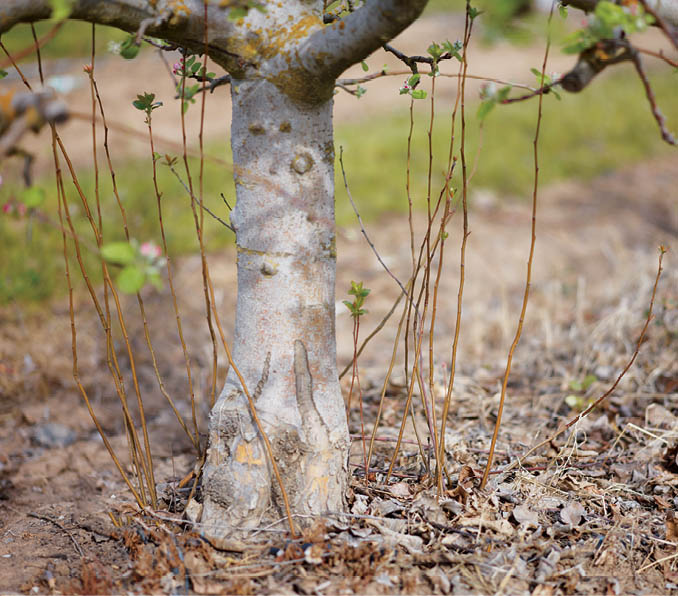
Suckers grow from rootstock below the graft.
Water sprouts are tall, aggressive upright shoots that grow from horizontal limbs, often in response to wounds or pruning cuts. Remove them. Water sprouts differ in character from ordinary branches. They grow faster than regular limbs, a tendency revealed by the wide placement of leaf nodes when you compare the two. Hard winter pruning often results in water sprouts. If a water sprout arises in a place where you want a limb to be, you can change its nature with corrective pruning and develop it into a useful, fruiting branch. Prune in summer above a well-directed bud to slow it down and encourage a more horizontal habit.
Prune suckers and water sprouts at any time of year. This type of growth saps a tree’s resources and is rarely productive.

A water sprout is a vigorous upright shoot that grows from a scaffold, often in response to a hard pruning cut.
For most deciduous fruit trees, fruit develops on fruiting spurs, with figs, nectarines, peaches, and persimmons being notable exceptions. Young trees don’t set much fruit for the first few years because fruiting spurs take two to four years to develop — no fruiting spurs, no fruit.
Spurs are relatively easy to spot. They differ in character from other buds and branches — short, thick, and somewhat stubby. Fruiting spurs are more likely to develop on more horizontal branches. In fact, bending an upright branch sideways and keeping it that way, along wires, by weighting branches, or with clothespins, creates physiological changes in the limb favorable to the development of fruiting spurs. Most fruiting spurs produce flowers and fruit for several years and eventually die off, but given adequate light falling on interior branches, fruit trees continually generate new spurs.

(L) Pome fruit spurs; (R) Stone fruit spurs
Some people go to great lengths to preserve fruiting spurs, but don’t bother. Fruiting spurs develop naturally. Cut some out, and more come along. When branches are removed with regular pruning, enough light penetrates the interior of a tree to maintain the continual development of fruiting spurs. Preserve too many branches in the interest of preserving spurs, and your tree will create so much interior shade that it won’t generate new ones.
If you prune regularly, spurs continue to develop on the older, more horizontal branches, which is exactly where you want them to be. Few spurs occur on the upright growth you prune off every summer, growth that is too weak to support much fruit anyway. It’s useful to know what spurs look like and what they are but more important to create a light-filled and well-formed tree. Rather than painstakingly preserving the fruiting spurs of today, open the interior of your tree to more sunlight and encourage the spurs of the future.
Prune your tree. Make it handsome. You can afford to lose some fruiting spurs.
If you still worry about pruning off fruiting spurs by mistake, be aware that a fruit tree is still dormant when it’s blooming. Save your dormant season pruning until the tree blooms in spring, and prune around the blossoms. Bear in mind, though, that cutting off flowers is a lot like cutting off unripe fruit; namely, emotionally difficult. Sound pruning decisions are easier to make when they’re not complicated by flowers.
You might want to watch for and preserve spurs on a young tree so you get the reward of a little harvest. We grow fruit trees for fruit and, for most of us, the sooner the better. I sometimes leave low branches on a tree for this reason, with the intention to remove them later. Short twiggy interior growth is often fruitful. You can prune off awkwardly placed branches once the harvest is in.
Some experts advise the removal of all fruit from a young tree. While thinning fruit is always a good idea, most fruit trees have more than enough vigor to manage a little fruit set early on, especially for backyard farmers eager for a first crop.
Try not to overthink the fruiting spur issue. Prune your tree. Make it handsome. You can afford to lose some fruiting spurs. Your fruit tree will still produce plenty of fruit. It will also be better positioned to produce fruit in the future.
Second only to the knee-high pruning cut, the most daunting task for almost all fruit growers is fruit thinning. The removal of immature fruit from a fruitful tree meets with deep emotional resistance. How could it not? All that abundance, all that beautiful potential condemned to the compost pile by one’s own hand. The better steward takes a long view, though. There are good reasons to do so.
Fruit thinning is as important as pruning for the overall health of the tree. A fruit tree more easily manages less fruit. Excessive fruit competes for available resources. According to the Cornell University Extension Service every apple needs about thirty leaves to support its development. By focusing nutrients into fewer fruits, thinning allows each remaining fruit to reach its full potential without taxing the resources of the tree. In addition, thinning keeps individual fruits separate. This reduces the spread of pests and disease. Thinning also helps to even out alternate bearing tendencies — the inclination for certain trees to bear heavily one year and lightly the next.

(L) Before thinning; (R) After thinning
Fruit thinning is good for trees. Fruit is heavy. The riper fruit gets, the heavier it becomes. If every fruit is allowed to ripen, the weight of that fruit strains the capacity of the tree. Even sturdy, well-pruned fruit trees set more fruit than they can possibly manage. Fruiting spurs on an apple tree set clusters of three to five apples each. Left unthinned, the weight of these apples pulls branches permanently downward into a dense, fountainy thicket. Apricots, plums, peaches, and nectarines can set hundreds of fruits up and down the limbs. Branches often break under the strain of this overabundance, even on pruned and managed trees.
Small fruit trees greatly simplify the fruit-thinning assignment.
Trees abort some overcroppage early in summer in a process called June drop. Don’t be alarmed when a tree sheds this immature fruit, but nor should you rely on trees to adequately thin themselves. Fruit growers have a responsibility to thin fruit. Conventional orchardists use chemicals for thinning. Backyard fruit growers thin by hand. Small fruit trees greatly simplify the fruit-thinning assignment.
Around the time of your solstice pruning, when fruit is about as big as the end of your thumb, thin clusters down to a single fruit. Thin larger fruits like apples and peaches to the stretch of a hand span or about eight inches apart. You may need to remove some apple clusters entirely. Keep smaller fruits like plums separate to the width of your fist or about five inches. Thin along branches. Preserve larger fruits and remove smaller ones. Remove fruit that shows signs of insects or disease. In an average season you might take off up to seventy-five percent of fruit set if you’re thinning correctly. Unthinned fruit may be abundant and seductive, but it’s hard on the tree. Better for both tree and grower to have fewer, superior, and evenly distributed fruits.
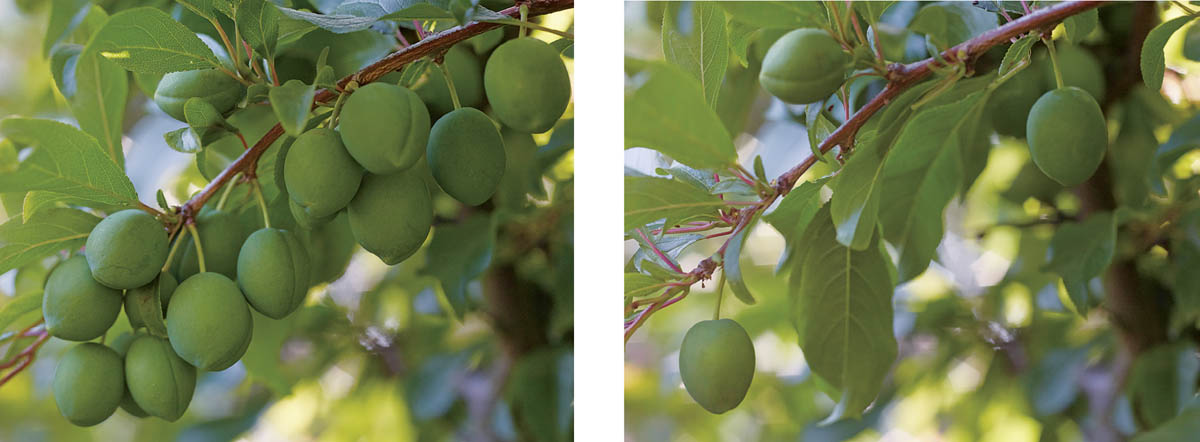
(L) Before thinning; (R) After thinning
Aesthetic pruning principles apply elements of bonsai to landscape pruning and operate at the intersection of art, Nature, and the science and craft of pruning. Aesthetic pruning is also a great way to prune a fruit tree. In the case of fruit trees, practices that remove limbs to create an open and idealized version of the tree also make the tree stronger and more fruitful.
An aesthetic pruner supports and emphasizes a tree’s natural growth habit much the way any craftsperson, like a cook or a haircutter, works with natural tendencies to heighten assets and downplay faults for highest use and the best aesthetic effect. An accomplished pruner works with the currents of Nature to create a better and more attractive tree.
Artful pruning creates space and supports and reveals the natural shape of a tree. The tree opens up and takes form.
Aesthetic pruners seek the “essence” of a tree, and they prune to support its most salient feature — for instance, an upright or spreading growth habit, distinctive bark, the delicate foliage of the Japanese maple, or the wild abandon of plums as compared to the steadiness of apples. I think that an essential feature of a fruit tree is not just its fruiting or form, but also its domesticity, its need for pruning and the companionability and care of people.
Another feature that defines aesthetic pruning is situational: how a plant works with the plants and the environment around it, and how a tree fits into a tight urban space or an expansive rural one and still maintains its character. This issue is critical for backyard fruit trees, which are better off small both because of the routine care they require and the space constraints in most ordinary gardens.
Stand back. Forget what you read on the Internet. Attend to the tree before you. Observe the growth pattern of the tree. In pruning, as in any good design, negative space plays an important role. Well-pruned trees have an airy quality. Yuki Nara of the website Way of Maple says that a bird can fly through a well-pruned Japanese maple — good standard for a fruit tree, too.
Let the tree offer you its own aesthetics. Your job only requires that you remove what doesn’t belong. Each pruning season creates a new response and builds on what we did (or didn’t do) before. Prune away confusion with the best artistic eye you can muster. Winter pruning is lighter than summer pruning and a little like the directive in a cookbook: correct the seasoning. Hard winter pruning results in extremely vigorous regrowth in spring. I avoid it, making only a few architectural thinning cuts per tree. Artful pruning creates space and supports and reveals the natural shape of a tree. The tree opens up and takes form.

If you’re unsure, mark errant limbs with blue masking tape before you prune them. This process lets you consider the effect of a pruning cut on the overall picture before the damage is done (and can’t be undone).
There are many paths to a well-pruned tree. Fruit trees are a combination of what they do and what you make them. You and your tree build the ideal as you go along. Right choices or wrong ones can be fairly arbitrary. Different pruners make different pruning decisions. In fact, the same pruner likely comes to a different decision on Tuesday than she would have on Wednesday. Trees grow. Each pruning season brings new opportunities. In the case of fruit trees especially, that you’re pruning is more important than precisely what you’re pruning.
An important first step? Develop a capacity to trust your decisions.
The first thing for any pruner to do is to stand back and observe the tree. Take a walk around it. Really look at it. Take it in. Now ask yourself the question, what’s bugging me? Certain branches will. They’re low. They droop. They’re sickly. They gather in a thicket. They cross other branches. They duplicate other branches. They’re stupidly placed. They head in the wrong direction. They’re wrong in some indefinable way. They grow right up through the center and crowd out sunlight. Relax, you don’t have to make any decisions or cut anything out just yet.
Get a roll of blue painter’s masking tape. Use this tape to tag branches where you might want to cut them. If you want to remove an entire limb, put the tape just above the collar. If you want to make a directional heading cut, consider which direction the bud is pointing because that’s the direction the resulting limb will grow. Put the tape above the bud. When you’re beginning, tape several branches and step back to consider how the tree will look without the tagged limbs.
John Iott likes to say that every pruning cut has two parts: the cut itself and how the tree grows in response. He suggests that you explain your thinking to yourself. What will this pruning cut achieve? What will the tree do next? If you make a heading cut, the branches behind the cut activate and grow. Do you need choices in this particular spot? More vigorous and bushy growth? Will the heading of this limb create too much shade? Will new growth fill an empty region of your tree? If you make a thinning cut, the limb will be removed completely and open up a space. Will the absence of the limb let light in and reveal a more handsome shape? Give other branches needed space?
The presence of the tape allows you to better imagine the absence of the branches. When you stand back, make your best guess. Sometimes it’s obvious. Sometimes it won’t much matter. Make the cut or don’t make the cut, as you choose, and move along with the tape to other limbs that bother you. If you’re unsure, leave the tape in place and come back to it later. Pruning creates a dynamic that can’t really be planned in advance, and for which there is no right answer. First choices shape later choices, and that’s the way it should be.
